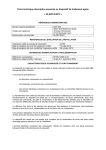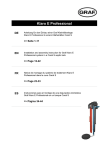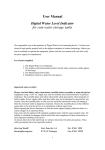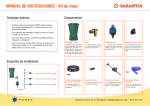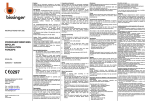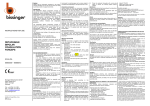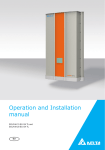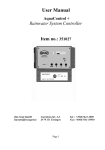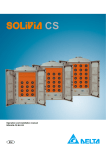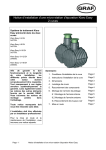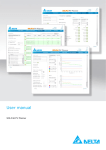Download External and internal Filter 3
Transcript
Installation and maintenance instructions for the GRAF Universal – External and internal Filter 3 English Universal Filter 3 for external green areas Order- No.: 340020 Universal – Filter 3 external for areas traversed by light traffic Order- No.: 340021 Universal – Filter 3 internal Order- No.: 340022 Modular add-on pack 2 Order- No.: 342002 The points described in these instructions must be followed correctly. If not correctly observed, any right to claim on the guarantee may be refused. For all additional GRAF articles purchased there are separate installation instructions enclosed in the transportation packing. Any missing instructions must be requested directly from us. A complete check of the tank for possible damage must be carried out before the installation in the excavation begins. The installation must be carried out by a professional firm. Contents 1. 1.1 1.2 2. 2.1 2.2 2.3 3. 3.1 3.2 4. 5. 5.1 5.2 5.3 5.4 6. General notes Safety Labelling/Tagging obligation Page 2 Installation requirements Page 2 Universal 3 pedestrian weight resistant Universal 3 for light traffic Universal 3 integrated Transport and storage Transport Storage Page 3 Technical data Page 3 Assembly / Installation of external Filter Preparation of the excavation Placing in the excavation and laying the connections Telescope installation Filling Page 4 6.1 6.2 6.3 6.4 Assembly / Installation of the Page 5 Universal 3 Internal Filter preparation Tank preparation Installing the Filter Assembly of the extraction mechanism 7. Commissioning and Service US Adaptation Copyright RainHarvest Systems, LLC Page 1 of 6 Page 6 1. General notes 1.1 Safety When working on the installation, the appropriate accident prevention regulations (in Germany BGV C22) must be followed. For safety reasons, especially when entering the tank, it is important that a second person is present. Furthermore, when carrying out assembly and installation work, inspection, maintenance and repairs, all work regulations and norms must be followed. You will find the advice in the appropriate sections of these instructions. The installation of the system and/or single equipment parts must be carried out by a professional worker. The complete system must always be out of operation and guarded against unauthorized use when carrying out work on the plant or parts of the system. The tank cover must always remain closed except when working in the tank, otherwise there exists a very high danger of accidents. The seating and condition of the cover must be checked on a regular basis. The GRAF Company offers an extensive range of accessories that are all compatible with one another and may be used to construct a complete system. The use of other manufacturers’ accessories can impair the function of the system and liability for any resulting damages will no longer be covered under the guarantee. 1.2 Labelling/Tagging obligation All pipe work and outlets of the water systems are to be labelled with the words “Not drinking water” either in words or graphically (German norm DIN 1988 Part 2, paragraph 3.3.2.) so that after years of use, an accidental connection to the drinking water system is prevented. Even when correctly labelled it may possibly be mistaken, for example by children. For this reason, all the outlets of the systems process water must be fitted with child safe valves. 2. Installation requirements 2.1 - 2.2 - - 2.3 - Universal – Filter 3 pedestrian weight resistant The Filter with the green telescopic attachment and cover may only be installed in green areas that are not traversed by traffic. The amount of short-term load of the polyethylene cover is max. 150 kg, the long-term area load max. 50 kg The maximum installation depth to the filter bottom is 1050 mm. Roof areas provided with a pipe connection of DN 100 = 350 m² and for DN 150 = 500 m². Universal – Filter 3 external for light traffic Through the use of the telescopic attachment (anthracite) and the cast iron cover Class B according to DIN EN 124 the filter may be installed in areas traversed by light traffic. Under no circumstances are the tanks to be installed in areas traversed by heavy goods vehicles or machinery (see point 5.3.2) The earth covering above the inlet supply pipe must be at least 450 mm; the maximum installation depth to the filter bottom is 1050 mm. Roof areas provided with a pipe connection of DN 100 = 350 m² and for DN 150 = 500 m². Universal – Filter 3 integrated The Filter is suitable for installation in a pilot shaft or in a cistern. The difference in height between the supply pipe and outlet is 250 mm The Filter may not be installed directly in the earth. The filter is suitable for roof areas up to 300 m². US Adaptation Copyright RainHarvest Systems, LLC Page 2 of 6 3.1 Transport During the transport the filter must be well secured against slipping or falling. If the Filter is to be secured for transportation with webbing straps, it is to be ensured that the filter remains undamaged. Stress and excess loading caused by impact are to be avoided. Under no circumstances is the filter to be rolled or slid over the ground surface. 3.2 Storage Any necessary temporary storage of the filter must be on an appropriate level surface without sharp objects. During the storage it is important to avoid damage caused by the surrounding environment or foreign objects. 4. Technical data US Adaptation Copyright RainHarvest Systems, LLC Page 3 of 6 English 3. Transport and storage 5. Assembly and installation of external Filter 5.1 Preparation of the excavation So that sufficient working room is available and the filter can be evenly embedded, the surface area of the excavation should exceed the filter dimensions on all sides by approximately 50 mm. The excavation slope is according to DIN 4124. The installations excavation must be level and smooth. The depth of the excavation must be measured so that the final installation depth of the filter bottom is a maximum 1050 mm. As an under surface for setting down, a layer of smooth sand with a grain size of 8/16 according to DIN 4226 – 1 and a layer depth of approximately 10 mm should be used. Important: The setting down surface for the filter must be absolutely level to ensure an optional performance. 5.2 Placing in the excavation and laying the connections The filter is installed in the prepared excavation and is then connected to the relevant pipes etc. Attention, it is important to note that all the pipes to be installed have a must have a gradient of at least 1% in the flow direction without sagging or bending downward. An emergency run-off must also be connected so that a congestion or back surge may be avoided. Important: DIN 1986 must be followed, therefore the diameter of the supply pipe = the diameter of the run-off pipe. 5.3 Telescope installation 5.3.1 Telescope pedestrian resistant The telescope is pressed into the filter housing from above. For excavation depths < 930 mm the telescopic attachment and in some circumstances, the filter housing must be shortened.It is important to pay attention that the inlet pipe is not obstructed in any way by the telescope when installed. Before pushing in the telescope the profiled sealing ring is placed in the housings recess. The telescope and the sealing ring must be thoroughly coated with the lubricating soap included in the delivery (use no lubrication that is mineral oil based). Attention: If the lubricating soap becomes dry and the telescope becomes difficult to move then there is the danger that the sealing ring will be forced out of its recess. Before filling, the sealing ring must be checked once again that it is seated correctly in position. The telescope must be sufficiently embedded and supported that no forces are transferred to the housing. 5.3.2 Telescope suitable for light traffic The telescope is installed as in Point 5.3.1. To ensure the function in areas traversed by light traffic, the telescope must be embedded around the collar with lean mixed concrete. The concrete encasement must be uninterrupted, 20 cm wide and approximately 30 cm deep. Attention: It is important to use the cast steel cover. Transport vehicle weight of heavy goods vehicles and machinery is not permitted. The telescope must be sufficiently embedded and supported that no forces are transferred to the housing. 5.4 Filling Important: Before and during the filling, the horizontal position of the filter must be checked. The lengthwise embedding of the filter is with smooth sand with a grain size of 8/16 according to DIN 4226 – 1 with a width of approximately 30 cm Each layer is to be of no more than 30 cm and must be tamped down lightly with a compacting machine or hand held tamper. Care must be taken during the embedding to ensure the filter is not damaged. To ensure that no forces are applied to the filter housing, the telescope must be well embedded and compacted. (For areas traversed by light traffic see section 5.3.2) Finally, the cover is set in place and secured so that it is child proof (Section 1.1 must be followed). The screws holding down the cover are to be made so tight that they can not be removed and the cover opened by a child! US Adaptation Copyright RainHarvest Systems, LLC Page 4 of 6 6. Assembly / Installation of the Universal 3 Internal Length of the HT/canalisation pipe – connections (completed on site) from the filter to the inlet connection and including the coupling: Diamant: 2.200 lt.: 3.350 lt.: 4.800 lt.: 6.500 lt.: 7.800 lt.: 9.200 lt.: Carat: 800 mm 1050 mm 1350 mm 1650 mm 1900 mm 2200 mm 2.700 lt: 3.750 lt: 4.800 lt: 6.500 lt: 7.500 lt: 9.600 lt: 13.000 lt: 1220 mm 1350 mm 1510 mm 1700 mm 1350 mm 1510 mm 1700 mm 6.2 Tank preparation The siphon is installed in the lowest seal (3) of the tank dome. The inlet pipe (150 mm long) is mounted on the side opening (1); the pipe is inserted from the outside. The emergency overflow (2) (pipe length 250 mm) is installed above the siphon (3) and is installed by pushing through from the inside. Important: The sealing ring from the HT – pipe coupling of the emergency overflow (2) must be removed. 6.3 Installing the Filter The fixing collar is pushed over the inlet pipe that is mounted on the tanks’ dome. Finally the prepared filter assembly is placed into the tank dome from above then connected with the emergency overflow and inlet pipe using the fixing collar. In this case it is a butt joint that requires no collar. 6.4 Assembly of the extraction mechanism Remove the seal from the filter basket and push the metal angle of the lift out mechanism over the rim as shown in the picture. Finally place the seal over the rim and pull back the metal angle. US Adaptation Copyright RainHarvest Systems, LLC Page 5 of 6 English 6.1 Filter preparation Before the installation in the tank, the filter must be prepared as shown in the adjacent depiction. 7. Commissioning and Service Before commissioning and at every inspection, the lifting out mechanism must be positioned at 90° to the inlet so that no large objects such a s leaves and twigs can catch on the handle. The straining filter is removed for cleaning and the basket must be thoroughly cleaned with water until all the pores are open. It is advised to clean every 4 to 5 weeks (more often in Autumn due to more leaves and twigs) or according to requirements. The filter strainer basket must be lightly pressed into place taking care that the seal sits precisely after every cleaning. At the occasion of each inspection, the overflow siphon must be checked and flushed in necessary. Otto GRAF GmbH, Carl-Zeiss-Straße 2-6, D- 79331 Teningen – Tel.: 0049/(0)7641/589-0, Fax: 0049/(0)7641/589-50 www.graf.info, [email protected], Stand: 01/08 GRAF Distribution SARL 45, route d'Ernolsheim, F- 67120 Dachstein-Gare – Tel.: 0033/388497310, Fax: 0033/388493280 www.graf.info, [email protected], Version: 01/08 GRAF IBERICA Tecnología del Plástico S.L. – Sant Miquel 37 – ES-17003 Girona – Tel.: 0034/972913767 – Fax: 0034/972913766 www.graf.info, [email protected], Versión: 01/08 US Adaptation Copyright RainHarvest Systems, LLC Page 6 of 6






